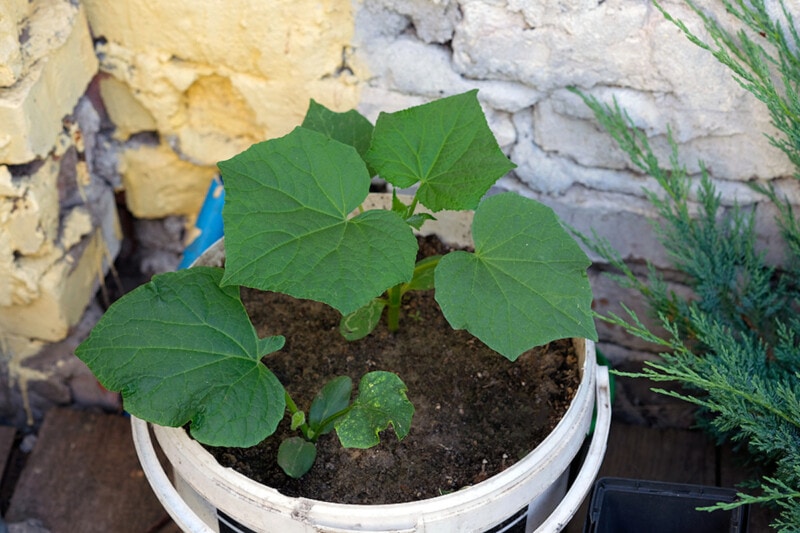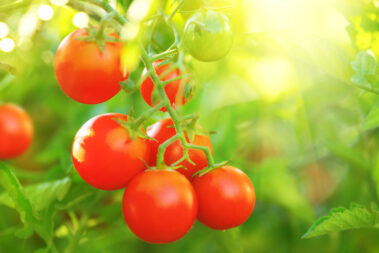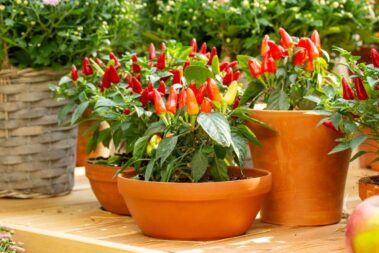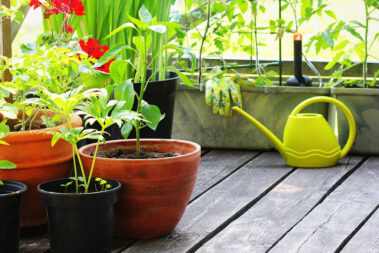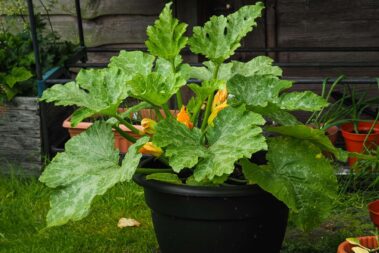While many vegetables in the cucurbit family are easy to grow (I’m looking at you zucchini), cucumbers tend to be a little more finicky. Luckily, growing cucumbers in pots can be easier than putting them in the garden.
In this article, we’ll give you our eight expert tips for growing cucumbers in pots and share some knowledge on the best varieties to choose and what to do with them after the harvest.
Table of Contents
8 Tips for Growing Cucumbers In Pots
Growing cucumbers can be a challenge. But these eight tips are guaranteed to help you find success growing cucumbers in your container garden.
1. Choose a sunny location
Cucumbers are big on sunlight, so look for areas that get at least 8 hours of direct sunlight each day.
Most varieties are heat tolerant, so a bright, sunny, south-facing wall generally works well. But also consider how easy it will be to water and harvest in that location.
Also, consider your trellis options for each possible location. Vining cucs require a large trellis–up to 8 feet high–or a lot of room to spread out along the ground. Bushy cucumbers, on the other hand, will only need a few feet to spread their leaves.
2. Pick the right pot
Plastic, ceramic, and even cloth pots all make excellent choices for growing cucumbers. Before deciding on which type of pot you’ll use, consider if you plan on moving the pots once they are full or if you expect to have to bring them inside (if you start them earlier in the spring or want to extend the season in the fall).
Ceramic pots are likely to be too heavy to heave around once they are filled with soil. While cloth pots are lighter, it is more difficult to contain the moisture that comes out of them, making them a poor choice for using indoors.
Whatever material you choose, just make sure the pot is at least 16 inches deep and a foot wide and can hold around 6 gallons of soil. This will provide plenty of space for most cucumber varieties. Vining types, however, will benefit from a larger, heavier pot, especially if you plan to train them to grow vertically.
Your pot should also have adequate drainage so excess moisture can run through each time you water.
3. Fill your pot with rich soil
Cucumbers require a lot of nutrients to produce the plethora of fruit they are known for. Because of this, it is vitally important to create a rich starting soil for your plants. When growing cucumbers in pots, this is even more important.
As with all container plants, cucumbers will benefit from a high-quality potting soil during their growing season. This special soil helps retain moisture and airflow better than traditional garden soil.
For cucumbers, in particular, you’ll also want to mix in plenty of compost or manure and some slow-release fertilizer. This will provide your developing plants with plenty of nutrients to get started on the right track and additional nutrients as they begin to produce fruit.
4. Direct sow your seeds
Cucumbers notoriously do not do well with transplanting. For this reason, it is better to buy seeds and direct sow them into your pots than to buy seedlings.
Once you have your soil prepared and well-watered, you are ready to plant your seeds.
Cucumbers are warm-season plants, which means they require soil over 60 degrees to germinate and are not tolerant to freezing temperatures. In most climates, you’ll want to start seeds about two weeks after the last frost date. Alternatively, you can move your pots inside and start seeds earlier, then move them outside once the weather warms.
Refer to your seed packet for specific instructions, but in general, you’ll want to plant your cucumber seeds about 1 inch below the soil surface. Plant three in each pot and thin down to the strongest plant once the seedlings have reached a couple of inches tall.
5. Water consistently and add fertilizer as needed
When your seedlings are small and the weather is still cool, you’ll only need to water every few days to keep the soil moist. After the plants get bigger, and especially once they start producing water-logged fruit, you will need to water more often.
The key is to keep the soil consistently moist to the touch at all times, without allowing the dirt to get soggy. Having good drainage holes in the bottom of your pot, or using a cloth pot that constantly drains, will help with this. Once the top of the soil dries, it is time to water again.
If you’re having to water overly frequently due to your pots drying out, try putting some mulch or straw on top. This insulation will help keep the soil moist for longer and reduce weed growth.
If you do the extra work of adding time-release fertilizer when you prepare your soil, you will only have to do supplemental fertilizing once the plants start producing. Creating a fertilizer tea out of grass clippings is a great, cost-effective way to add nutrients. Otherwise, you can use a diluted liquid fertilizer.
In either case, add the fertilizer every three to four weeks throughout the summer growing season.
6. Tame and maintain
Before your seedlings get too big, you’ll want to prepare your trellis or cage.
For bush varieties that you want to train to grow vertically (to reduce space needs and increase airflow), all you need is a tomato cage. Place the cage over the seedling and gently push the vines back inside the wires every few days until they start crawling up.
For vining varieties, you will need to build a long trellis using posts and mesh, netting, or strings. Netting that you would use for peas or beans is a great option, as is chicken wire. Or, if you have a fence, you can place your containers near it and let your vines grow on that.
You can also train vines up individual strings for a quick DIY trellis option. Just avoid mesh with holes larger than a ½ inch since developing fruit can get caught and stuck in larger holes.
7. Harvest all summer long
Some cucumber varieties start producing within two months of sowing. Others will take closer to three months. But all will provide continuous fruit throughout the hotter months and into fall.
Harvest cucumbers often (before they start to swell with seeds). This will make for tastier fruit and encourage more production for a higher yield.
When taking fruit off the vine, be sure to use scissors or pruners to carefully clip the stem. Pulling or twisting the fruit will damage the sensitive vines and potentially kill any fruits growing upstream.
Fresh cucs can be stored on the counter for a couple of days or in the fridge for a few weeks.
You can also harvest cucumber flowers to eat. Male flowers can be harvested a day or two after they start producing pollen without affecting your yield. Female flowers can also be eaten, but doing so will reduce how many cucumbers you’ll have to harvest.
8. Prepare for colder temperatures
Cucumber production will start to slow as soon as temperatures begin to drop in the fall. But the plant won’t die until the first frost.
If you expect an early cold-snap with warm weather to follow, you can use a sheet to protect your large plants or bring smaller, bush varieties indoors.
If you do expect a hard freeze and still have fruits on the vine, pick anything that is close to ripe so you don’t lose it.
Expert Tip: Plant the Right Cucumber Variety
Like most cucurbits, cucumbers come in two main types: bush and vining. Within each category, there are specific varieties that tend to do well when planted in pots.
Bush Cucumbers
As you can imagine, bushy cucumbers are best suited for life in a container. These compact plants only grow up to about three feet long. This makes containing them in pots much easier, especially if you have limited floor or vertical space around your container garden.
When left to their own devices, these types will cascade down the side of the pots but won’t venture much farther. They can also be trained to grow vertically using a tomato cage or similar setup.
Some of our favorite commercial and heirloom bush cucumber varieties for growing in pots are:
- Bush Slicer – This robust dwarf cuc produces long, straight fruits on short vines. These hardy plants are resistant to disease and grow well in cool and hot weather.
- Pick a Bushel – This compact plant produces short, two-foot-long vines and develops fruit early–perfect for short-season climates. They do well in medium-sized pots.
- Salad Bush – This undersized plant produces full-sized cucumbers. It was designed to grow in tighter spaces and is perfect for smaller containers.
- Spacemaster – As the name entails, this cucumber was selectively bred to grow well in restricted environments. It puts out short vines with medium-sized fruits and matures quickly so you can start enjoying your harvest sooner.
Vining Cucumbers
Vining cucumbers are a great choice for your vegetable garden but take a little more work to grow in containers. Though, it certainly can be done. And, because these types tend to produce a lot more fruit, the rewards can be well worth it.
If you do choose a vining cucumber, you have two choices in how to deal with those long vines. You can allow them to cascade down the pots and over the ground around your container garden, or you can tame them to trellises.
Many of these types of cucumbers can grow up to eight feet long, so be sure you have the horizontal or vertical space to spare before you pick up any of these seed varieties.
Here are some of our favorite vining cucumber varieties for growing in pots:
- Diva – This special vining variety does not require pollination by insects to produce fruit, which makes it a great choice for container gardens on apartment balconies and other areas that don’t get a lot of bees.
- Lemon – These eight-foot-long vines produce fun, round, yellowish fruits that are perfect for snacking. While not compact, they tolerate containers very well.
- Suyo Long – This Asian variety produces long vines with long fruit–up to fifteen inches! These perfect slicers are slightly sweet and always a hit.
Common Problems You Might Face
Cucumbers are sensitive to many pests and diseases. Here are a few issues that may impact your container-grown cucumbers.
- Angular leaf spot – This bacterium causes lesions on cucumber leaves that develop into angular holes. This disease will spread quickly through infected ground gardens but the most likely culprit in container gardens is infected seeds. Getting your seeds from a reputable nursery is the best way to avoid this issue.
- Powdery mildew – Like all cucurbits, the wide leaves of the cucumber plant are prone to this fungus, which causes white, powdery residue to cover the foliage. Training vines to grow vertically where there is better airflow and less moisture buildup will help you avoid problems with this disease.
- Cucumber beetles – These yellow and black beetles are dangerous to cucs for two reasons. Not only do the adults chomp on the leaves, but the larvae feed on the roots of the plant. The best defense against these pests when growing cucumbers in pots is to keep the plants a good distance away from ground gardens and other foliage.
- Aphids – Aphids typically feed on the underside of cucumber leaves and are only a problem when populations get out of hand. Luckily, they are easy to remedy by spraying the leaves with a mix of warm water and dish soap.
- Squash bugs – As nymphs, squash bugs will feed on cucumber leaves, causing distinct yellow spots. Mature beetles will chew on leaves causing excessive damage that can kill young plants. Luckily, you can kill nymphs easily using soapy water, while adults will have to be removed by hand.
FAQ
What supports cucumbers in pots?
There are a variety of materials you can use to support cucumbers growing in pots. Tomato cages work well, as do pea trellis, bamboo stakes and string, and chicken wire.
What do you plant next to cucumbers?
When planting cucumbers in small containers or pots, don’t plant any additional plants along with them. There isn’t enough space or soil for multiple root systems. But if planting in a large raised container, companion planting with peas or beans can help cucumbers get the nitrogen they need.
What temperatures do cucumber plants need?
Cucumbers grow best at temperatures between 70 and 80 degrees. Any hotter and you’ll want to water more frequently to help keep them hydrated. Any cooler and they may stop flowering.
How to Use Your Harvest
By putting our above tips to use, you are sure to end up with a huge harvest. Here are some of our favorite recipes that put the fresh taste of homegrown cucumbers front and center.
- Easy Vegan Summer Pasta Salad – This salad with cucumber slices is refreshing and filling–perfect for any summer evening.
- Easy Homemade Vegan Sushi – Cucumbers add a lot of texture and fresh flavor to some of these homemade sushi rolls.
- Chickpea & Cucumber Salad – Protein-packed and tasty–what more do you want out of a salad?
- Vegan Cobb Salad with Coconut Bacon Bits – The coconut bacon bits try to steal the show, but homegrown cucumbers will hold their own in this delicious salad.
Still have cucumbers leftover? Here are ten things to do with cucumbers when you have more than you can eat all at once.
If you love the idea of growing and making your own pickles, don’t forget to grow dill and other herbs in your garden, too!
And, if you like these tips, don’t forget to sign up for our newsletter to get helpful gardening and cooking articles delivered straight to your inbox.
Growing Cucumbers in Containers Has Never Been Easier
With the right spot, right pot, and our helpful tips above, even the most novice gardeners can grow plentiful cucumbers. Don’t forget to choose the right cuc variety to fit your needs and space, and if you need cucumber recipe inspiration after your harvest, check back here for our favorite recipes.
If you have questions or comments about growing cucumbers, be sure to post them in the comments section below.
- How to Pick the Perfect Watermelon For a Sweet Summer Treat - April 10, 2024
- Future Kind’s Foundations: A Multivitamin Made for Vegans - December 5, 2023
- Does Nutritional Yeast Go Bad? - November 28, 2023

